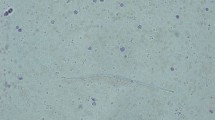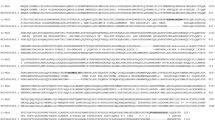Abstract
Blastomycosis is a systemic fungal disease of humans and other animals produced by the thermally dimorphic fungal organism, Blastomyces dermatitidis. Recent studies have focused on the utilization of antibody and antigen detection in the development of immunoassays for the diagnosis of blastomycosis. This study was designed to evaluate four B. dermatitidis yeast lysate antigenic preparations from human isolates (591, 592, 597, 598) from an outbreak of blastomycosis in Eagle River, Wisconsin. The indirect enzyme-linked immunosorbent assay (ELISA) was used to compare these four antigens for their ability to detect antibodies in 28 serum specimens from immunized rabbits and in 18 sera from dogs with blastomycosis. This study also compared antibodies prepared from each of the four B. dermatitidis lysate antigens for their ability to detect antigen using the competitive enzyme-linked immunosorbent assay in 18 urine specimens from the same dogs as above with blastomycosis. All four reagents proved to be immunoreactive and were able to detect antibody in the rabbit and dog sera and antigen in each of the urine specimens with only slight variations in the mean absorbance values evidenced. Antibody detection, mean absorbance values with the four lysates, ranged from 1.522 (592 antigen) to 2.047 (597 antigen) in the rabbit sera and from 1.504 (591 antigen) to 1.878 (597 antigen) in the dog sera. Antigen detection, sensitivity values obtained with the antibodies prepared from the four lysates, ranged from 89% (598 serum) to 100% (591 and 592 serum specimens).



Similar content being viewed by others
References
DiSalvo AF. Blastomycosis, in Topley and Wilson’s Microbiology and Microbial Infections, Arnold Publishers, London, UK, 9th edition. 1998; 337–355.
Pfaller MA, Diekema DJ. Epidemiology of invasive mycoses in North America. Crit Rev Microbiol. 2010;36(1):1–53.
Benedict K, Roy M, Chiller T, et al. Epidemiologic and ecologic features of blastomycosis: a review. Curr Fungal Infect Rep. 2012;6:327–35.
Bradsher RW. The endemic mimic: Blastomycosis an illness often misdiagnosed. Trans Am Clin Clim Assn. 2014;125:188–203.
Bradsher RW, Chapman SW, Pappas PG. Blastomycosis. Infect Dis Clin NA. 2003;17:21–40.
Bariola KR, Vyas KS. Pulmonary blastomycosis. Semin Respir Crit Care Med. 2011;32:745–53.
Smith JA, Gauthier G. New developments in blastomycosis. Semin Respir Crit Care Med. 2015;36:715–28.
Castill CG. Kaufman, Micell MH. Blastomycosis. Infect Dis Clin NA. 2016;30:247–64.
Saccente M. Woods GL Clinical and laboratory update on blastomycosis. Clin Microbiol Rev. 2010;23:367–81.
McKinnell JA, Pappas PG. Blastomycosis: New insights into diagnosis, prevention, and treatment. Clin Chest Med. 2009;30:227–39.
Spector D, Legendre AM, Wheat J, et al. Antigen and antibody testing for the diagnosis of blastomycosis in dogs. J Vet Int Med. 2008;22:839–43.
Klein BS, Squires RA, Lloyd JK, et al. Canine antibody response to Blastomyces dermatitidis WI-1 antigen. Am Rev Vet Res. 2000;61:554–8.
Vyas KS, Bariola JR, Bradsher RW. Advances in the serodiagnosis of blastomycosis. Curr Fungal Infect Rep. 2008;2:227–31.
Bariola JR, Hage CA, Durkin ME, et al. Detection of Blastomyces dermatitidis antigen in patients with newly diagnosed blastomycosis. Diag Microbiol Infect Dis. 2011;69:187–91.
Connolly P, Hage CA, Bariola JR, et al. Blastomyces dermatitidis antigen detection by quantitative enzyme immunoassay. Clin Vacc Immunol. 2012;19:53–6.
Hage CA, Davis TE, Egan L, et al. Diagnosis of pulmonary histoplasmosis and blastomycosis by detection of antigen in bronchoalveolar lavage fluid using an improved second-generation enzyme-linked immunoassay. Resp Med. 2007;10:43–7.
Frost HM, Novicki TJ. Blastomyces antigen detection for diagnosis and management of blastomycosis. J Clin Microbiol. 2016;53:3660–2.
Hage CA, Ribes JA, Wengenack NL, et al. A multicenter evaluation of tests for diagnosis of histoplasmosis. Clin Infect Dis. 2011;53:448–54.
Durkin M, Estok L, Hospenthal D, et al. Detection of Coccidiolides antigenemia following dissociation of immune complexes. Clin Vacc Immunol. 2009;16:1453–6.
Theel ES, Jespersen DJ, Harring J, et al. Evaluation of an enzyme immunoassay for detection of Histoplasma capsulatum from urine specimens. J Clin Microbiol. 2013;5:3555–9.
Johnson SM, Scalarone GM. Preparation and ELISA evaluation of Blastomyces dermatitidis yeast phase lysate antigens. Diag Microbiol Infect Dis. 1989;11:81–6.
Shurley JF, Legendre AM, Scalarone GM. Blastomyes dermatitidis antigen detection in urine specimens from dogs with blastomycosis using a competitive binding inhibition ELISA. Mycopathologia. 2005;160:137–42.
Shurley JF, Scalarone GM. Comparison of Blastomyces dermatitidis yeast phase lysate antigens for their use as diagnostic reagents in the competitive inhibition ELISA for the detection of blastomycosis. J Med Biol Sci. 2007;1:1–4.
Andrae D, Birch K, Bybee T, et al. Antigen detection in canine blastomycosis: comparison of different antibody–antigen combinations in two competitive ELISAs. Open J Med Microbiol. 2012;2:110–11.
Searle A, Scalarone GM. Comparative antibody study for antigen detection in urine specimens for diagnosis of blastomycosis using a competitive enzyme-linked immunosorbent assay. Open J Immunol. 2012;2:139–43.
Boyd AR, Poole JB, Sorensen J, et al. Antigen detection in urine specimens from dogs with blastomycosis: comparative ELISA determinations with serum from rabbits immunized with Blastomyces dermatitidis dog isolates. US Open Anim Health Vet Med J. 2014;1:1–7.
Chester EM, Axtell RC, Scalarone GM. Blastomyces dermatitidis lysate antigens: antibody detection in serial serum specimens from dogs with blastomycosis. Mycopathologia. 2003;156:289–94.
Sestero CM, Scalarone GM. Detection of IgG and IgM in sera from canines with blastomycosis using eight Blastomyces dermatitidis yeast phase lysate antigens. Mycopathologia. 2006;162:33–7.
Shurley JF, Scalarone GM. Isoelectric focusing and ELISA evaluation of a Blastomyces dermatitidis human isolate. Mycopathologia. 2007;164:73–6.
Hatch WO, Scalarone GM. Development of a slide agglutination assay for the detection of blastomycosis. Microbiol Immunol (Wiley Pub). 2013;57:756–61.
Klein BS, Vergeront JM, Weeks RJ, et al. Isolation of Blastomyces dermatitidis in soil associated with a large outbreak of blastomycosis in Wisconsin. New Eng J Med. 1986;314(9):529–34.
Klein BS, Vergeront JM, Kaufman L, et al. Serologic tests for blastomycosis: assessments during a large point-source outbreak in Wisconsin. J Infect Dis. 1987;155(2):262–8.
Scalarone GM, Levine HB, Chaparas SD. Delayed hypersensitivity responses of experimental animals to histoplasmin from the yeast and mycelial phases of Histoplasma capsulatum. Infect Immun. 1978;21:705–13.
Levine HB, Scalarone GM, Chaparas SD. Preparation of fungal antigens and vaccines: studies on Coccidioides immitis and Histoplasma capsulatum. Contrib Microbiol Immunol. 1977;3:106–25.
Levine HB, Scalarone GM, Campbell GD, et al. Histoplasmin-CYL, A yeast phase reagent in skin test studies in humans. Am Rev Respir Dis. 1979;119:629–36.
Acknowledgements
This study was supported by the Department of Biological Sciences at Idaho State University.
Author information
Authors and Affiliations
Corresponding author
Ethics declarations
Conflict of interest
The authors declare that they have no conflict of interest.
Ethical Approval
All procedures performed in studies involving animals were in accordance with the ethical standards of the institution or practice at which the studies were conducted.
Additional information
Publisher's Note
Springer Nature remains neutral with regard to jurisdictional claims in published maps and institutional affiliations.
Handling Editor: Sudha Chaturvedi.
Rights and permissions
About this article
Cite this article
Hammon, J.T., Kennell, B.C. & Scalarone, G.M. Blastomyces dermatitidis Antibody and Antigen Detection: Comparison of Four Lysate Antigens and Antibodies Prepared from Human Isolates from a Blastomycosis Outbreak. Mycopathologia 184, 661–666 (2019). https://doi.org/10.1007/s11046-019-00385-0
Received:
Accepted:
Published:
Issue Date:
DOI: https://doi.org/10.1007/s11046-019-00385-0




